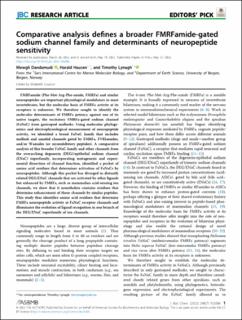Comparative analysis defines a broader FMRFamide-gated sodium channel family and determinants of neuropeptide sensitivity
Journal article, Peer reviewed
Published version

View/
Date
2022Metadata
Show full item recordCollections
- Department of Earth Science [1034]
- Registrations from Cristin [9489]
Abstract
FMRFamide (Phe-Met-Arg-Phe-amide, FMRFa) and similar neuropeptides are important physiological modulators in most invertebrates, but the molecular basis of FMRFa activity at its receptors is unknown. We therefore sought to identify the molecular determinants of FMRFa potency against one of its native targets, the excitatory FMRFa-gated sodium channel (FaNaC) from gastropod mollusks. Using molecular phylogenetics and electrophysiological measurement of neuropeptide activity, we identified a broad FaNaC family that includes mollusk and annelid channels gated by FMRFa, FVRIamides, and/or Wamides (or myoinhibitory peptides). A comparative analysis of this broader FaNaC family and other channels from the overarching degenerin (DEG)/epithelial sodium channel (ENaC) superfamily, incorporating mutagenesis and experimental dissection of channel function, identified a pocket of amino acid residues that determines activation of FaNaCs by neuropeptides. Although this pocket has diverged in distantly related DEG/ENaC channels that are activated by other ligands but enhanced by FMRFa, such as mammalian acid-sensing ion channels, we show that it nonetheless contains residues that determine enhancement of those channels by similar peptides. This study thus identifies amino acid residues that determine FMRFa neuropeptide activity at FaNaC receptor channels and illuminates the evolution of ligand recognition in one branch of the DEG/ENaC superfamily of ion channels.
